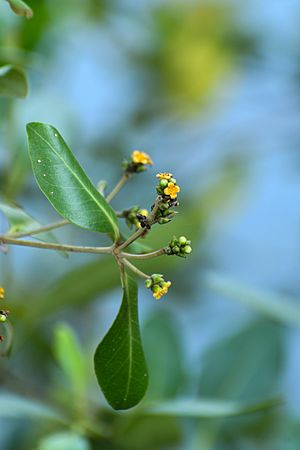Avicennia officinalis facts for kids
Quick facts for kids Avicennia officinalis |
|
|---|---|
 |
|
| Indian mangrove | |
| Scientific classification | |
| Genus: |
Avicennia
|
| Species: |
officinalis
|
Avicennia officinalis, also known as the Indian mangrove, is a special type of tree that grows in salty areas. When it's young, this tree looks like a short, bushy plant. As it gets older, it grows into a tall, straight tree, reaching up to 15 meters (about 50 feet) and sometimes even 30 meters (nearly 100 feet) high!
Its leaves are shiny green and grow in pairs. Each leaf is about 10 cm long and 5 cm wide, with a rounded tip. The underside of the leaves is a golden-brown color. The flowers are the biggest among all Avicennia species. They are about 6 to 10 mm wide and can be orange-yellow or lemon-yellow. The tree's bark is smooth and ranges from dirty green to dark gray. It has small cracks but doesn't peel off. The fruit is heart-shaped, green or brown, and about 2.5 cm long. It narrows sharply into a small point.
Contents
Where the Indian Mangrove Grows
The Indian mangrove is often found along river banks, but rarely right next to the sea. It prefers to grow in clay soil and is usually found further inland.
Countries Where You Can Find It
This amazing tree grows in many countries across Asia and Oceania. You can find it in:
- Bangladesh
- Brunei
- Cambodia
- India
- Indonesia
- Malaysia
- Myanmar
- Papua New Guinea
- Philippines
- Singapore
- Sri Lanka
- Thailand
- Vietnam
Traditional Uses of the Fruit
Long ago, the fruit of the Indian mangrove was an important food source for some Indigenous Australians, especially those living in Cleveland Bay, Queensland. They had special ways to prepare the fruit to make it safe and tasty to eat.
How the Fruit Was Prepared
Indigenous Australians would bake the fruit using hot stones in a pit. After baking, they would soak the softened fruit in water. This process helped remove any bitterness and made the fruit ready to eat. This food was especially helpful during the wet season when it was hard to find other types of food.
A sailor named Murrell, who was shipwrecked and lived with the Indigenous people of Cleveland Bay for 17 years, shared his observations about how they used this plant.
See also
 In Spanish: Avicennia officinalis para niños
In Spanish: Avicennia officinalis para niños


